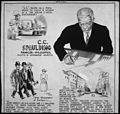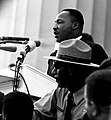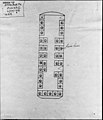Portal:Civil rights movement
The civil rights movement portal The civil rights movement was a social movement and campaign from 1954 to 1968 in the United States to abolish legalized racial segregation, discrimination, and disenfranchisement in the country. The movement had its origins in the Reconstruction era during the late 19th century and had its modern roots in the 1940s, although the movement made its largest legislative gains in the 1960s after years of direct actions and grassroots protests. The social movement's major nonviolent resistance and civil disobedience campaigns eventually secured new protections in federal law for the civil rights of all Americans. After the American Civil War and the subsequent abolition of slavery in the 1860s, the Reconstruction Amendments to the United States Constitution granted emancipation and constitutional rights of citizenship to all African Americans, most of whom had recently been enslaved. For a short period of time, African-American men voted and held political office, but as time went on Blacks were increasingly deprived of civil rights, often under the racist Jim Crow laws, and African Americans were subjected to discrimination and sustained violence by white supremacists in the South. Over the following century, various efforts were made by African Americans to secure their legal and civil rights, such as the civil rights movement (1865–1896) and the civil rights movement (1896–1954). The movement was characterized by nonviolent mass protests and civil disobedience following highly publicized events such as the lynching of Emmett Till. These included boycotts such as the Montgomery bus boycott, "sit-ins" in Greensboro and Nashville, a series of protests during the Birmingham campaign, and a march from Selma to Montgomery. At the culmination of a legal strategy pursued by African Americans, in 1954 the Supreme Court struck down the underpinnings of laws that had allowed racial segregation and discrimination to be legal in the United States as unconstitutional. The Warren Court made a series of landmark rulings against racist discrimination, including the separate but equal doctrine, such as Brown v. Board of Education (1954), Heart of Atlanta Motel, Inc. v. United States (1964), and Loving v. Virginia (1967) which banned segregation in public schools and public accommodations, and struck down all state laws banning interracial marriage. The rulings played a crucial role in bringing an end to the segregationist Jim Crow laws prevalent in the Southern states. In the 1960s, moderates in the movement worked with the United States Congress to achieve the passage of several significant pieces of federal legislation that authorized oversight and enforcement of civil rights laws. The Civil Rights Act of 1964 explicitly banned all discrimination based on race, including racial segregation in schools, businesses, and in public accommodations. The Voting Rights Act of 1965 restored and protected voting rights by authorizing federal oversight of registration and elections in areas with historic under-representation of minority voters. The Fair Housing Act of 1968 banned discrimination in the sale or rental of housing. (Full article...) Selected article - The U.S. Congress enacted major amendments to the Voting Rights Act of 1965 in 1970, 1975, 1982, 1992, and 2006. Each of these amendments coincided with an impending expiration of some of the Act's special provisions, which originally were set to expire by 1970. However, in recognition of the voting discrimination that continued despite the Act, Congress repeatedly amended the Act to reauthorize the special provisions. In each of these amendments except for the 1992 amendments, Congress extended the special provisions that were tied to the coverage formula, such as the preclearance requirement. These provisions were extended for five years in 1970, seven years in 1975, and 25 years in both 1982 and 2006. In 1970 and 1975, Congress also expanded the coverage formula, supplementing it with new 1968 and 1972 trigger dates. Coverage was further enlarged in 1975 when Congress expanded the meaning of "tests or devices" to encompass any jurisdiction that provided English-only election information, such as ballots, if the jurisdiction had a single language minority group that constituted more than five percent of the jurisdiction's voting-age citizens. These expansions brought numerous jurisdictions into coverage, including many located outside of the South. To ease the burdens of the reauthorized special provisions, Congress liberalized the bailout procedure in 1982, allowing covered jurisdictions to escape coverage by upholding the voting rights of protected minorities and affirmatively acting to expand minority political participation. In addition to reauthorizing the special provisions and expanding coverage, Congress amended and added several other provisions to the Act. For instance, Congress expanded the original ban on "tests or devices" to apply nationwide in 1970, and in 1975, Congress made the ban permanent. Separately, in 1975 Congress expanded the Act's scope to protect language minorities from voting discrimination. Congress defined "language minority" to include "persons who are American Indian, Asian American, Alaskan Natives or of Spanish heritage." Congress amended various provisions, such as the Section 5 preclearance requirement and Section 2 general prohibition of discriminatory voting laws, to prohibit discrimination against language minorities. (Full article...)General imagesThe following are images from various civil rights movement-related articles on Wikipedia.
Related portalsWikiProjectsSelected biography -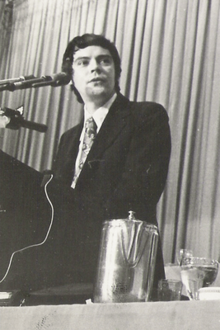 Tom David Kahn (September 15, 1938 – March 27, 1992) was an American social democrat known for his leadership in several organizations. He was an activist and influential strategist in the Civil Rights Movement. He was a senior adviser and leader in the U.S. labor movement. Kahn was raised in New York City. At Brooklyn College, he joined the U.S. socialist movement, where he was influenced by Max Shachtman and Michael Harrington. As an assistant to civil rights leader Bayard Rustin, Kahn helped to organize the 1963 March on Washington, during which Martin Luther King Jr. delivered his "I Have a Dream" speech. Kahn's analysis of the civil rights movement influenced Bayard Rustin (who was the nominal author of Kahn's "From Protest to Politics"). (This article, originally a 1964 pamphlet from the League for Industrial Democracy, was written by Kahn, according to Horowitz (2007, pp. 223–224). It remains widely reprinted, for example in Rustin's Down the Line of 1971 and Time on two crosses of 2003.) (Full article...)Selected image -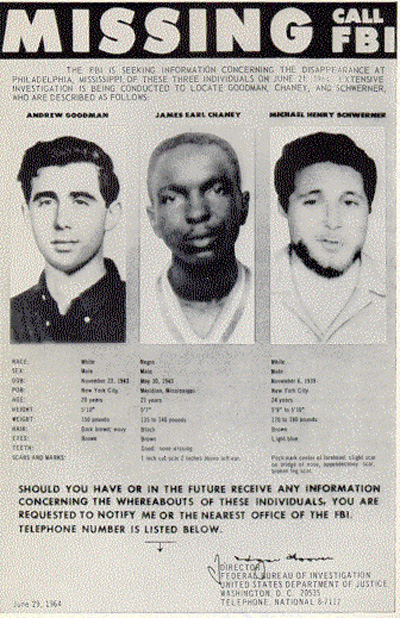 Missing persons poster created by the FBI in 1964, signed by the Director J. Edgar Hoover. Shows the photographs of Andrew Goodman, James Chaney, and Michael Schwerner. All three were found to have been later murdered by local White Knights of the Ku Klux Klan, and the Neshoba County Sheriff's Office as well as the Philadelphia, Mississippi Police Department were involved in the incident. Did you know?
TopicsSubcategoriesThings to doAssociated WikimediaThe following Wikimedia Foundation sister projects provide more on this subject:
Discover Wikipedia using portals
|







